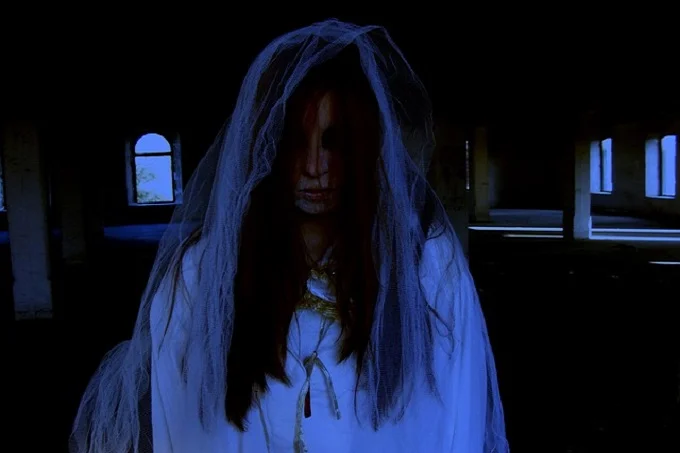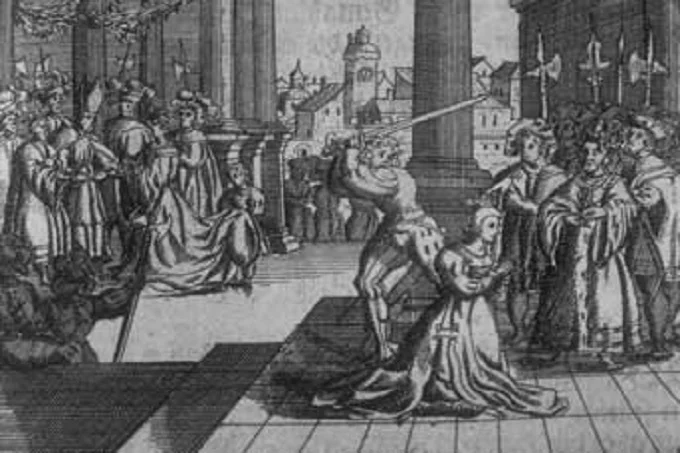Which ghost has an official court decision, “certificate of identity” and “residence permit in the Royal Tower”?

This incredible trial has no analogs in world history. It began in London in 1861 and lasted for several years. During this time, the military court turned into a historical investigation, which led to two completely sensational results: firstly, the grave of Queen Anne Boleyn was found, and secondly, her ghost received not only real confirmation of its existence, but also an identity card. Yes, that’s right! And this is not the nonsense of drunken judges, but the result of a trial involving the country’s most respected historians.
This mysterious and almost absurd story began in the middle of the blessed month of May 1861 in the Tower. The sun was setting. The last ray gilded the ancient walls, and darkness reigned.
The security officer cursed when he found that he had not taken the flashlight. But suddenly, a light flashed from the side. Someone lit candles in St. Peter’s Chapel. The guardian was curious and not fearful. Of course, the old books told about the many ghosts of the Tower.
Of course – for eight centuries of its existence, this castle housed the residence of English kings, a place of trial, a prison, execution platforms, a repository of royal treasures, a museum, and even the first English zoo. But the officer himself did not believe in any ghosts and therefore decided that someone had illegally entered the guarded premises. And therefore, it is necessary to take measures.
In two jumps, the officer overcame the tiny square in front of the chapel, put a ladder, and looked inside. But what he saw made him cling to the handrails tighter…
A procession was slowly passing through the chapel – about fifty people in richly decorated antique costumes. The figures swayed gently in the strange light that came directly from the floor. As they approached the altar, the figures disappeared – they seemed to be sucked under the floor.
A woman walking at the end of the procession turned around. The officer caught the look of her black, beautiful, and tragic eyes. The light flashed for the last time – and everything disappeared. The only thing the officer managed to see was that on the neck of the stranger were not jewels, but a pendant with the Latin letter “V”.
Returning to the guardhouse, the guard took up the historical directory. There he read that, according to legend, the ashes of Henry VIII’s executed wife, the beautiful Anne Boleyn, rest in St. Peter’s Chapel. The execution took place on May 19, 1536. The officer glanced at his watch–midnight had just struck. It began on May 19, 1861 – exactly 325 years have passed since the execution.

So, the jubilee returned and began to move around the castle. Most often, the guards encountered her in the corridor of the main Tower – it was not far from there that there was a room where Anna spent the last days before her execution. The ghost appeared at night – all in white, sometimes, terrifying, without a head. But the monogrammed pendant always glowed on the neck.
There was a real commotion in the castle. Several soldiers and attendants who met with the ghostly queen were hospitalized with a diagnosis of “hallucination”, and several more wrote petitions for dismissal.
And once, during a round, the captain found a sentry unconscious on the floor. When the poor man came to himself, he said that a woman in white had floated out of Anna’s room. He ordered her to stop, but she was moving right at him. Then he pierced her with a bayonet, but the bayonet went through the air. It was then that he realized that it was a ghost, and fainted.
Everything would have been forgotten, but at that time, the ruling royal family was expected to visit the Tower. The sentry’s behavior was qualified as treason to the crown, and he was brought before the tribunal. That’s where the other witnesses also submitted their reports to the authorities. And a real investigation began, to which the military court-involved historians.
It turned out that Anna appeared at the royal residence in the Tower at the end of January 1533, when the English king Henry VIII solemnly announced his second marriage. All over the castle – on canopies and drapes, on tablecloths and towels – Anna ordered to embroider the monogram “B” – the first letter of her surname and the motto: “The happiest”.
The king fell in love with her back in 1526, when he was already 35 years old, and she was only 19. For seven years, they waited. Everyone was against their marriage: Henry’s first wife, Catherine of Aragon, to whom he had been married for more than 20 years, and the pope, who refused to give the king permission for divorce, and the courtiers who were plotting, and the common people who loved Catherine and therefore hated Anna.
No one took into account that Anna was educated, spoke many languages, played musical instruments. But she, who had lived in France for several years, was instantly dubbed a “French whore”. But then, what did King Henry care about everyone? He was selfish, hot-tempered, and cruel, he believed that the world existed solely for his pleasure. And if he decided to take a second wife – a young beauty, the pope is simply obliged to divorce him from the first – an old and boring one. If the pope does not do this, Henry will do without him. And let the pope lose power over England altogether!
Said and done. Henry VIII rejected Catholicism and proclaimed an Anglican Church independent of Rome. He became its head himself. Well, can at least one state boast that because of the king’s love for a woman, the whole country has changed the form of confession? And England can! However, most of the country took the innovations with hostility. It is not surprising that the enemies nicknamed Anna the black-eyed witch.
Moreover, the girl had a bodily sign, which at that time was attributed to a witch: she had two nails on one of the fingers of her right hand. Besides, she could “cook herbs”. And therefore, when a terrible pestilence began in London in the summer of 1528, the townspeople accused Anna of it. But most importantly, the girl wore closed dresses. And that’s why there was talk – she had black moles on her body and an ugly fatty under her neck. But how did Henry, a connoisseur of ladies’ beauties, fall in love with such a scarecrow? Very simply, the popular rumor explained: since Anna was a witch, she drugged the king.
In fact, Anna was sweet and beautiful. And even kind, because she donated a lot of money to the poor. But on September 7, 1533, instead of the expected heir to the throne, she gave birth to a girl, and the hard-hearted Henry immediately cooled down to his former love. Could he have imagined that this particular girl, whom he himself would later declare illegitimate, would become the greatest queen of England? After all, Anne Boleyn gave birth to the future Elizabeth I!
But Henry did not look into the future. He had already looked for a new lover and decided to simply execute Anna. There was also a reason: Boleyn was accused of witchcraft, and at the same time of cheating on her husband. And on a beautiful sunny day on May 19, 1536, her head was cut off in the same Tower, where she was crowned three years before.

The king was waiting for news of the execution in a boat on the Thames. They say that when he heard the warning volley, he stamped his foot and exclaimed: “It’s done! Let’s have fun!” The next morning he was married to the new queen – Jane Seymour.
To get the latest stories, install our app here
The historians’ stories were long, the court listened to them with pleasure. It’s a free education! The process lasted several years. But everything has an end, and the historical excursions have ended. “Everyone knows,” historians finally declared, “that ghosts most often appear at their resting place, but where Anne Boleyn’s grave is unknown.” And then the court decided to make an investigative experiment, to open the floor in St. Peter’s Chapel, where the security officer first saw a strange luminous procession.
Everyone was interested in the question: why did Anna appear here, were there any real reasons for this? And in the autumn of 1866, carpenters and masons opened the old floor. A real historical find was discovered under the stone slabs – there really were the remains of Anne Boleyn and almost hundreds of her executed friends and relatives.
To confirm the authenticity of the royal remains, papers were lifted from the Tower archive. Everything was confirmed: forgotten for centuries, Anne Boleyn and her entourage really lay there.
And so, having considered the “case on the merits”, having heard historians, having reviewed archival documents, and interviewed contemporary witnesses, the military court recognized the incredible – the presence of the ghost of Anne Boleyn – and as a result acquitted the sentry.
Now Anna is the only ghost in the world who has an official court decision on her existence. Moreover, a “certificate of identity” and a “residence permit in the Royal Tower” were issued to the ghost. In a word, everything is royal for kings. I wonder if this would happen if a simple city girl turned out to be a ghost?..




